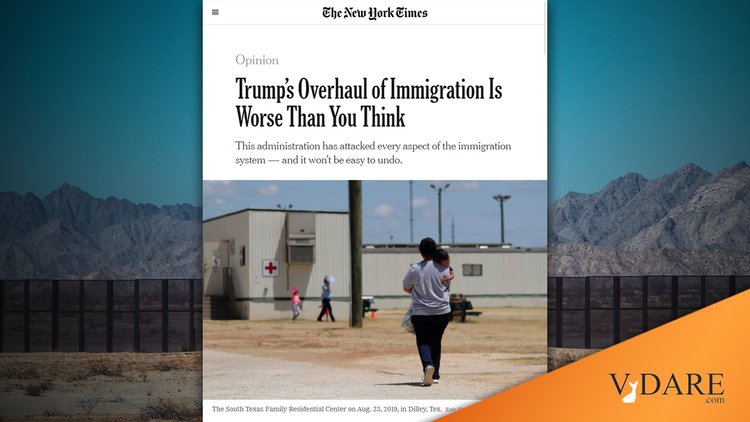The New York Times Editorial Board condemned President Trump’s immigration policies last weekend. According to the Times, Trump has made terrific strides in this area and his actions will shape our immigration system to come. “This transformation of the American immigration system has been perhaps the administration’s boldest accomplishment,” the editorial board writes [Trump’s Overhaul of Immigration Is Worse Than You Think, by The Editorial Board, NYT, October 10, 2020].
That’s a terrible thing to the paper of record, but immigration patriots will find it welcome news. Without the hysteric attacks, the column reads more like a list of accomplishments than misdeeds.
The editorial board notes that immigration has plummeted under Trump:
Between 2016 and 2019, annual net immigration into the United States fell by almost half, to about 600,000 people per year — a level not seen since the 1980s — according to an analysis by William H. Frey of the Brookings Institution. (Since the start of the coronavirus pandemic, that number has certainly decreased even more.)
The 2016-19 drop “is clearly a result of Trump’s restrictive immigration measures,” Mr. Frey told the editorial board, “including immigrant bans from selected countries, greater limits on refugees, and generating fear among other potential immigrant groups over this administration’s unwelcoming policies.” [LInks in original throughought]
The Times complains that Trump amped up immigration enforcement and beefed up border security.
In the spring of 2018, as thousands of Central American families crossed the southern U.S. border to seek asylum, the Justice Department ordered the arrest of anyone entering the country without authorization. This forced the separation of hundreds of families, even the removal of infants from nursing mothers.
….
Border control officials said they would accept asylum applications only from people who arrived at approved border crossings, even though the law says anyone can apply for asylum once in the United States. At those crossings, asylum seekers were forced to wait for days, even weeks, in long lines just for a chance to approach the border to ask for protection. The White House packed the immigration appeals board with Trump appointees, with predictable results: Rejections increased.
Mr. Trump also used the threat of tariffs to get Mexico to crack down on undocumented Central American immigrants and to allow frustrated asylum seekers to wait on the Mexican side of the border while their cases meandered through U.S. immigration courts.
After Mr. Trump suspended aid to El Salvador, Guatemala and Honduras in March, Guatemala and Honduras agreed to accept asylum seekers who had passed through those countries on their way north, so they could either apply for asylum there or go home.
Trump famously promised to crack down on criminal aliens in the 2016 campaign, but the Times complains his focus “has been far broader.” “He has also eagerly pursued reductions in authorized immigration,” the editorial says.
Mr. Trump eventually achieved a version of his Muslim ban when the Supreme Court approved of severe restrictions on entry for residents of 13 countries, the majority of them with mostly Muslim populations. While the White House said one reason the ban was needed was lax security in those countries, it also has drastically scaled back the refugee program, which involves stringent vetting by American and United Nations officials. In Barack Obama’s last year as president, the ceiling for refugee admissions was 110,000. For the current fiscal year, it’s 15,000.
Despite Mr. Trump’s promises to protect Americans from killer immigrants, Immigration and Customs Enforcement is now more than twice as likely to pick up immigrants with no criminal record beyond immigration violations, compared with the number before he took office. After being labeled the “deporter in chief,” Mr. Obama ordered ICE to concentrate enforcement on unauthorized immigrants who had committed crimes. Within weeks of his own inauguration, Mr. Trump eliminated any deportation priorities and made all undocumented immigrants fair game for ICE. With many cities resisting ICE’s more stringent demands for cooperation, the agency has also found it easier to just pick up anyone with an existing deportation warrant.
…
At the same time, applications for permanent residency have declined since the administration announced it would adopt a rule that would prevent those considered likely to receive public benefits from becoming permanent residents. Among recent green-card recipients, 69 percent had at least one of the characteristics that would be weighed, according to the Migration Policy Institute.
Ken Cuccinelli, the acting deputy secretary of homeland security, recently announced that the number of H-1B visas for skilled workers would be cut by one-third because of tighter criteria for who can get them. Critics said this would make American companies shift more work abroad.
Mr. Trump also has ended “temporary protected status” for 400,000 people from El Salvador, Haiti, Sudan and elsewhere who have legally lived and worked in the United States for decades after being provided a haven from war or natural disaster.
What may be the best endorsement of all is the editorial board’s gripe that these changes may be permanent.
“There’s so much change that has happened in the last four years, there’s no way a new administration could reverse things in four or even eight years,” said Sarah Pierce, a policy analyst at the Migration Policy Institute who was a co-author of the group’s July report.
The New York Times surprisingly published one of the strongest endorsements of President Trump in 2020. The Editorial Board makes it clear: despite his inability to pass new legislation on, for example, Birthright Citizenship, Trump is delivering on immigration.













